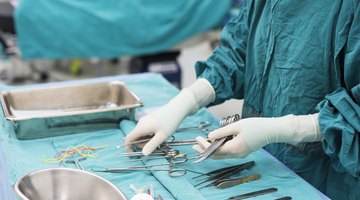The names of surgical instruments must be learned for many medical professions. Not only do surgeons need to know the terminology, but so do nurses and the staff members who prepare the operating room. Other careers such as dentistry and medical research also require knowledge of some surgical tools. Some nursing or medical classes will have a brief overview of the surgical instruments, but unless you are using them on a routine basis it is easy to forget the exact names. Reviewing on your own is an excellent way to supplement your classroom instruction.
If you've taken relevant classes, review your textbooks and class notes on a frequent basis. The books you have from your classes that covered surgical instruments should have pictures and descriptions of the tools used in surgery. To make "flashcards" to test your knowledge, cover the names of the tools with a piece of paper or a sticky note to see how many you can remember.
Find a surgical supply catalog. These catalogs are filled with pictures and details about hundreds of surgical instruments. Study the catalog as you would a textbook and try the "flashcard" technique described in step 1 to test yourself.
Go online to a surgical instrument teaching site. The website Surgical Instrument Pictures (surgical-instrument-pictures.com) gets excellent reviews from nursing school and medical student forums for its comprehensiveness. The website has an instrument index as well as a page where you can test yourself. The site also describes the functions of the tools.
Download the e-book "Learning Surgical Instruments" by James A. Nideffer. The e-book can be purchased directly from the Surgical Instruments Pictures website; the e-book or hard copy is available from online bookstores such as Amazon. Study the book's pictures and descriptions as you would any textbook.
Study the tools themselves. There is no substitute for learning by actually handling the surgical instruments. Through your school, request access to where surgical instruments are stored to quiz yourself on their names (keep your catalog or textbook handy for reference). Handle the tools and learn how they function and feel in your hand.
Tip
Combine the above steps to get a well-rounded learning experience.
Warning
Ask permission before handling any surgical tools that aren't a part of the classroom.
Related Articles
References
Tips
- Combine the above steps to get a well-rounded learning experience.
Warnings
- Ask permission before handling any surgical tools that aren't a part of the classroom.
Writer Bio
Based in Portland, Ore., Tammie Painter has been writing garden, fitness, science and travel articles since 2008. Her articles have appeared in magazines such as "Herb Companion" and "Northwest Travel" and she is the author of six books. Painter earned her Bachelor of Science in biology from Portland State University.











